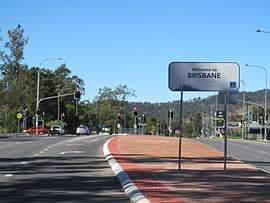Ferny Grove, Queensland
| Ferny Grove Brisbane, Queensland | |||||||||||||
|---|---|---|---|---|---|---|---|---|---|---|---|---|---|
 Samford Road, 2013 | |||||||||||||
| Coordinates | 27°24′11″S 152°55′41″E / 27.40306°S 152.92806°ECoordinates: 27°24′11″S 152°55′41″E / 27.40306°S 152.92806°E | ||||||||||||
| Population | 5,609 (2011 census)[1] | ||||||||||||
| • Density | 1,476/km2 (3,820/sq mi) | ||||||||||||
| Postcode(s) | 4055 | ||||||||||||
| Area | 3.8 km2 (1.5 sq mi) | ||||||||||||
| Location | 11 km (7 mi) from Brisbane | ||||||||||||
| LGA(s) | City of Brisbane | ||||||||||||
| State electorate(s) | Ferny Grove | ||||||||||||
| Federal Division(s) | Brisbane | ||||||||||||
| |||||||||||||
Ferny Grove is a residential suburb 11km north-west Brisbane, Queensland, Australia. Its local government area is Brisbane City Council.
The size of Ferny Grove is approximately 4 km². It has 8 parks covering nearly 13% of the total area. There are three schools and two childcare centres.
Demographics
In the 2011 census, Ferny Grove recorded a population of 5,609 people, 50.5% female and 49.5% male.[1] The median age of the Ferny Grove population was 38 years of age, 1 year above the Australian median. 78.8% of people living in Ferny Grove were born in Australia, compared to the national average of 69.8%; the next most common countries of birth were England 5%, New Zealand 2.6%, South Africa 1.7%, Scotland 0.9%, India 0.9%. 91.1% of people spoke only English at home; the next most popular languages were 0.5% Afrikaans, 0.5% Cantonese, 0.4% Punjabi, 0.4% German, 0.3% Spanish.[1]
The population in 1996 was 5,016 people. By 2001 the population was 6,011, with a population growth of 20% over those five years. The predominant age group is 10 – 19 years. Households primarily contain couples with children who repay between $800 and $1000 per month on mortgage. In general, people work as clerks. In 1996, 75% of homes were owner-occupied, compared to 75% in 2001. The Average sale price of houses is $525,000 (15/12/2014).
History
Before the Second World War, Ferny Grove was mainly known for its pleasant picnic grounds along the banks of Kedron Brook and large areas of forest and fern filled valleys, one of which gives the suburb its name.
Before large-scale residential development, Ferny Grove was primarily industrial, containing a large claypit and tile factory operating south of the railway station. When this factory ceased operation in the 1960s, Ferny Grove was redeveloped for housing.
After the war, while the area was still largely residentially undeveloped, the Brisbane City Council operated a nightsoil sanitation depot beside Cedar Creek. The depot closed in the late 1960s as more of Brisbane was laid with sewerage infrastructure and the need for nightsoil treatment ended. After lying vacant for some years, the depot was leased by the Council to the Brisbane Tramway Museum Society, and is now the home of the Brisbane Tramway Museum.
The City Council continued to use the area south of the former nightsoil depot as a large refuse tip until the late 1980s. Ironically, the ferny grove from which the suburb took its name is no longer there; for, situated at the present site of rubbish dump 40 years old, the grove was buried under a large hill, upon which the City Council now operates a waste transfer station and sports playing fields.
Transport
The Ferny Grove railway station is now the terminal of the railway line of the same name. Until 1955 the railway line continued to Dayboro and Ferny Grove was merely a minor station on the line. The line is now supplied with electricity at 25 kV AC. There are many bus routes.
References
- 1 2 3 Australian Bureau of Statistics (31 October 2012). "Ferny Grove (State Suburb)". 2011 Census QuickStats. Retrieved 25 October 2013.
External links
| Wikimedia Commons has media related to Ferny Grove, Queensland. |
- Ferny Grove: Queensland Places
- "Ferny Grove". BRISbites. Brisbane City Council. Archived from the original on 19 July 2008.
- "Ferny Grove". Our Brisbane. Brisbane City Council. Archived from the original on 24 January 2008.
- Cedar Creek cemetery at Ferny Grove